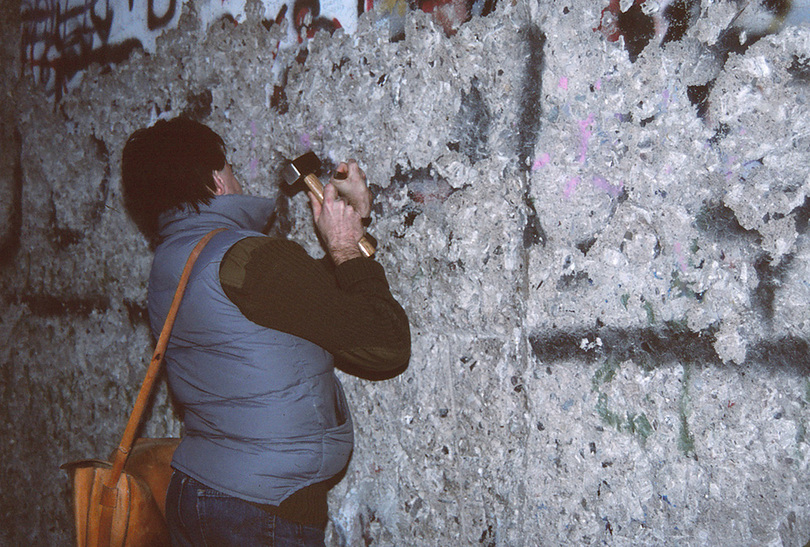Librarian reflects on fall, effect of Berlin Wall during 25th anniversary
In December of 1989, Peter Verheyen was chipping away at the remains of the Berlin Wall.
Verheyen, who lived in West Germany from 1984–87, went to Berlin on a trip with his family just a month after the destruction of the wall began. He stood before the wall with a sledgehammer and did his part to tear it down.
The Berlin Wall divided East and West Berlin for 28 years, and this Sunday marks the 25th anniversary of the wall’s destruction. After World War II, the Berlin Wall split the city into two sections — the East controlled by the Soviet Union and the West controlled by France, the United Kingdom and the United States. For many years, the wall was considered a physical metaphor for the divide between the USSR and the U.S.
Even though a quarter of a century has passed, the lessons from the wall live on through people like Verheyen, a librarian and research and emerging issues analyst at Syracuse University.
“It was night and day,” Verheyen said, comparing Berlin before and after the wall was brought down.
Verheyen and his parents emigrated to the United States from Germany in the 1960s. He grew up speaking, reading and writing German, and moved back to Germany after college to study book conservation.
He described the contrast between Berlin in 1984 and in 1989 as “surreal.” The breakdown of one of the most physically and symbolically secure borders in the world transformed the feeling of the city from hostile to open.
“When I was living there, you had this very clear delineation between East and West. It’s like watching an old war movie or an old spy movie,” Verheyen said. “To be able to walk through there, to be able to basically vandalize the enemies’ defenses — they were able to watch you literally break it away — I don’t think it was anything that anybody expected to happen that quickly when it did.”
Though he was excited to play a part in the wall’s destruction, Verheyen felt sorry for the East Berlin guards he saw on the other side of the wall. The young men he described as adolescent-looking had to stand still, watching him and others destroy the defenses they had been loyally protecting for so long.
“If you study the history, you see the emotions. You look people in the eye, and you can kind of see this person isn’t really comfortable with what’s happening,” Verheyen said.
Laurie Marhoefer, an assistant history professor in the Maxwell School of Citizenship and Public Affairs, said the effects that the destruction of the wall had on the people of East Berlin are often overlooked.
It’s still a difficult memory for some.
“There were good things and bad things — it was a mixed bag,” Marhoefer said. “A lot of people who had lived in East Germany were nostalgic for it.”
There is even a word in German for this nostalgia for life in East Germany: “Ostalgie.”
But for Verheyen, tearing down the wall was a victory for peace. He said he felt elated as he helped to tear it down — it released his tension.
Verheyen was proud to make such a peaceful political statement.
But the feelings of that day and the faces of the soldiers are not ones that Verheyen can easily forget. Though it’s 25 years later, they are still with him.
He relived them as recently as Oct. 25 when he recognized the anniversary of the wall’s destruction at the Tearing Down the Wall event at SU event. The event included breaking down a symbolic art installation representing the wall and a panel discussion called “Why We Remember the Wall.”
“As was pointed out in one of the panel discussions, most of the people there — certainly the students — weren’t even born yet. I think having young people connect with the past was a really good thing,” Verheyen said.
Verheyen, his sister Esther, who also attended the event, and Marhoefer all viewed the peacefulness in the destruction of the Berlin Wall as a lesson in resolving conflicts — a lesson that’s still relevant 25 years later.
“You can have a situation that’s so challenging and resolve it in a nonviolent way. It’s a good message for people today because so much of our political action involves war and confrontation,” Esther Verheyen said. “Just the reminder that there are also ways to peacefully make progress.”
Though the Berlin Wall came down 25 years ago, there are still walls — some literal and others figurative — in today’s world.
Said Verheyen: “We’re still building walls all over the place as quickly as we can, whether it’s in the near east, along the border of Mexico or in our minds. I think it’s better to tear those down or not even start them.”
In the Nov. 6 article “Librarian reflects on fall, effect of Berlin Wall during 25th anniversary,” the area where Peter Verheyan lived in Germany was incorrect. He lived in western Germany. The date of the destruction of the Berlin Wall was misstated. The anniversary was on Sunday. The Daily Orange regrets these errors.
Published on November 6, 2014 at 12:01 am
Contact Alex: aerdekia@syr.edu








